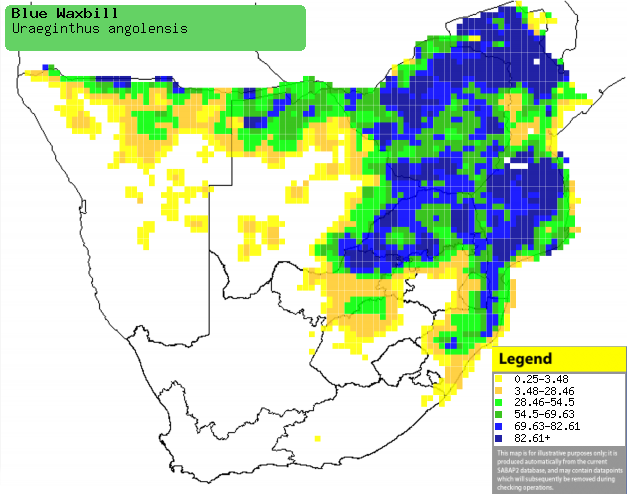|
Uraeginthus angolensis (Blue
waxbill)
Gewone blousysie [Afrikaans]; Katjikilili gomuburau
[Kwangali]; Kasisi [Shona]; Mswili [Swazi]; Xindzingiri (generic term for
waxbill or pytilia) [Tsonga]; Angolees blauwfazantje [Dutch]; Cordonbleu
de l'Angola [French]; Angola-schmetterlingsfink [German]; Peito-celeste
[Portuguese]
Life
> Eukaryotes >
Opisthokonta
> Metazoa (animals) >
Bilateria >
Deuterostomia > Chordata >
Craniata > Vertebrata (vertebrates) > Gnathostomata (jawed
vertebrates) > Teleostomi (teleost fish) > Osteichthyes (bony fish) > Class:
Sarcopterygii (lobe-finned
fish) > Stegocephalia (terrestrial
vertebrates) > Tetrapoda
(four-legged vertebrates) > Reptiliomorpha > Amniota >
Reptilia (reptiles) >
Romeriida > Diapsida > Archosauromorpha > Archosauria >
Dinosauria
(dinosaurs) > Saurischia > Theropoda (bipedal predatory dinosaurs) >
Coelurosauria > Maniraptora >Aves
(birds) > Order: Passeriformes
> Family: Estrildidae
Distribution and habitat
Mainly occurs in Africa south of the Equator, from southern
DRC and Tanzania through Angola and Zambia to southern Africa. Here it is common
from Mozambique, Zimbabwe and north-eastern South Africa to northern and eastern
Botswana and northern Namibia. It generally prefers mesic and semi-arid savanna,
especially with umbrella thorns (Acacia tortilis), also occupying natural
growth in cultivated land, Mopane (Colosphermum mopane) and edges of
evergreen forest.
|
 |
|
Distribution of Blue waxbill in southern Africa,
based on statistical smoothing of the records from first SA Bird Atlas
Project (©
Animal Demography unit, University of
Cape Town; smoothing by Birgit Erni and Francesca Little). Colours range
from dark blue (most common) through to yellow (least common).
See here for the latest distribution
from the SABAP2. |
Predators and parasites
It has been recorded as prey of the following animals:
It is also a host of the tick Hyalomma marginatum.
Food
It mainly eats seeds taken directly from grass
inflorescences, supplemented with termites and other insects. The following food items have been recorded
in its diet:
- Plants
- seeds
- grass
- Melinis repens (Natal red top)
- Panicum schinzii (Sweet buffalo grass)
- Panicum maximum (Guinea grass)
- Setaria verticillata (Bristle grass)
- Tricholaena monachne (Blue-seed grass)
- Urochloa mosambicensis (Bushveld signal grass)
- Sporobolus (dropseed grass)
- forbs
- Portulaca oleracea (Purslane)
- fallen fruit of Boscia albitrunca (Shepherds-tree)
- Insects
Breeding
- The nest is built by both sexes, consisting of an oval-shaped structure
with a short entrance tunnel on the side, made of grass stems and
inflorescences and lined with feathers. It is typically placed in the
foliage of a bush or tree, especially Umbrella thorn (Acacia tortilis)
and Sickle bush (Dichrostachys cinerea), often near a wasps' nest.
There is no evidence that wasps deter nest predators, however it is possible
that birds use wasp nests as a way of working out whether there are arboreal
ants (Psuedomyrmex) in the tree, as if they are around they would
attack the nest of any wasps or birds. It may also use the nest of another
bird, such as Scarlet-chested sunbird, Spectacled weaver or Black-chested
prinia, although with the latter it still builds a structure on top of the
original one.
- Egg-laying season is year-round, usually peaking in January, roughly two
months after a period of heavy rainfall.
- It lays 2-7 eggs, which are incubated by both sexes in about 11-12 days.
- The chicks are fed by both parents on a diet of green grass seeds and
termites, leaving the nest permanently after about 17-21 days. They are
capable of fending for themselves after about a week, becoming fully
independent after another week or so.
Threats
Not threatened.
References
-
Hockey PAR, Dean WRJ and Ryan PG 2005. Roberts
- Birds of southern Africa, VIIth ed. The Trustees of the John Voelcker
Bird Book Fund, Cape Town.
|
